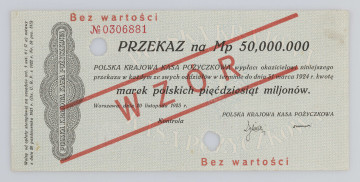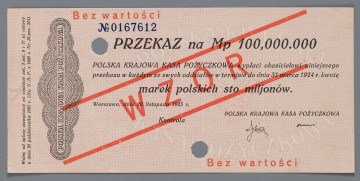
Cheque for 50,000,000 Polish marks - a template
1923
National Museum in Lublin
Part of the collection: Paper money during the Second Polish Republic
After the First World War (1914-1918), the currency situation in the reborn Poland was chaotic. Issues of the partitioning states were in circulation: German marks, Russian roubles and Austro-Hungarian crowns. In addition, in the north-eastern areas of the Second Polish Republic, the German roubles of the Eastern Bank in Poznań and the marks of the Eastern Loan Fund in Kaunas, as well as iron kopecks, were in circulation. In Eastern Galicia Ukrainian hryvnias and carbuncles were in use. In the General Government created by Germany, the Polish marks (mkp) were put into circulation from April 1917 through the Polish National Loan Fund (PKKP). The far from stable situation of the young state did not allow for the creation of the Bank of Poland and a national currency. For a while, the function of an issuing bank was taken over by the polonised PKKP, and the Polish mark became a temporary currency. The reduction of the mkp to the role of an exclusive means of payment was gradual. It was finally done after the ruble was annulled in the Borderlands in July 1921 and the German mark in Upper Silesia in December 1922.
The banknote in question was preceded by other independence issues: 500 mkp of 15 January and 100 mkp of 15 February 1919. Apart from the first one, modelled on the 100 mkp, the subsequent ones were original designs by an outstanding Polish graphic artist Adam Jerzy Półtawski (died in 1952). The issue of 17 May 1919 included the denominations: 1, 5, 20, and 1000 mkp, were introduced into circulation in 1920 in the following order: 1000 mkp (15 July), 20 mkp (20 September), 5 mkp (1 October) and 1 mkp (18 March). The banknotes designed by Adam Półtawski, through the images of Tadeusz Kościuszko (20, 100 and 1000 mkp) and Bartosz Głowacki (5 mkp), were supposed to reinforce the attitudes of national solidarity, embodied by the heroes from Racławice - a nobleman and a peasant.
At the time of the introduction of the 1,000 mkp, "Kurier Warszawski" offered one herring for 65 pfennigs, fat milk for 1.5 mkp, French men's shirts for 46 mkp, and a violin for 1,500 mkp. At the same time, striking workers employed by the Ministry of Public Works demanded a wage increase to 3 mkp per hour. By the end of June 1919, a dollar cost 17.5 mkp.
Tomasz Markiewicz
Author / creator
Dimensions
cały obiekt: height: 210 mm, width: 131 mm
Object type
paper money
Technique
Material
paper
Creation time / dating
Creation / finding place
Owner
The National Museum in Lublin
Identification number
Location / status

1923
National Museum in Lublin

1923
National Museum in Lublin

1923
National Museum in Lublin
DISCOVER this TOPIC
National Museum in Lublin
DISCOVER this PATH
Educational path